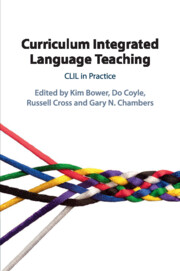Book contents
- Curriculum Integrated Language Teaching
- Curriculum Integrated Language Teaching
- Copyright page
- Contents
- Figures
- Tables
- Contributors
- Foreword
- Preface
- Acknowledgements
- Part I The Educational Context for CLIL
- Part II Current Aspects of Practice in CLIL
- Part III New Knowledge and Future Directions
- 8 Lessons to Be Learned
- 9 Supporting Peer Collaboration and Social Cohesion in Multilingual Classrooms
- 10 Exploring the Potential of a Pluriliteracies Approach
- Afterword
- Index
- References
8 - Lessons to Be Learned
A Professional Development Approach to Curriculum Planning in a Multilingual School in Galicia
from Part III - New Knowledge and Future Directions
Published online by Cambridge University Press: 27 July 2020
- Curriculum Integrated Language Teaching
- Curriculum Integrated Language Teaching
- Copyright page
- Contents
- Figures
- Tables
- Contributors
- Foreword
- Preface
- Acknowledgements
- Part I The Educational Context for CLIL
- Part II Current Aspects of Practice in CLIL
- Part III New Knowledge and Future Directions
- 8 Lessons to Be Learned
- 9 Supporting Peer Collaboration and Social Cohesion in Multilingual Classrooms
- 10 Exploring the Potential of a Pluriliteracies Approach
- Afterword
- Index
- References
Summary
This chapter focuses on how integrated curriculum planning and implementation in a trilingual setting might provide useful insights for those working with CLIL, across what would appear to be very different and specific linguistic contexts including multilingual and Anglophone contexts. We draw on relevant lessons learned from a detailed longitudinal case study in Galicia to highlight key areas for consideration and analysis across different contexts. This experience emphasized four key factors that emerged from the study that we suggest are transferable to other linguistic contexts: training/professional learning for teachers, a literacies approach that facilitates pluriliteracies development, teacher collaboration where language and content teachers co-construct the CLIL curriculum together and implement their designs across CLIL lessons and ownership of CLIL pedagogies.
Keywords
- Type
- Chapter
- Information
- Curriculum Integrated Language TeachingCLIL in Practice, pp. 145 - 164Publisher: Cambridge University PressPrint publication year: 2020
References
- 3
- Cited by



